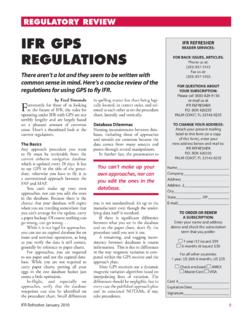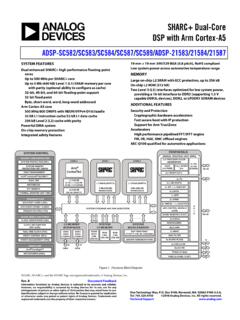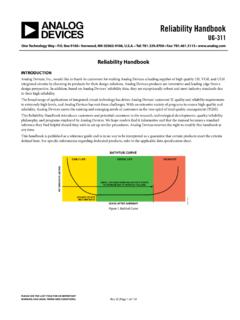Transcription of Valgrind Documentation
1 Valgrind Documentation Release 15 Oct 2021. Copyright 2000-2021 AUTHORS. Permission is granted to copy, distribute and/or modify this document under the terms of the GNU Free Documentation License, Version or any later version published by the Free Software Foundation; with no Invariant Sections, with no Front-Cover Texts, and with no Back-Cover Texts. A copy of the license is included in the section entitled The GNU Free Documentation License. This is the top level of Valgrind 's Documentation tree. The Documentation is contained in six logically separate documents, as listed in the following Table of Contents. To get started quickly, read the Valgrind Quick Start Guide. For full Documentation on Valgrind , read the Valgrind User Manual. Valgrind Documentation Table of Contents The Valgrind Quick Start Guide .. iii Valgrind User Manual .. iv Valgrind FAQ .. clxxviii Valgrind Technical Documentation .
2 Viii Valgrind Distribution Documents .. xvii GNU Licenses .. clxi 2. The Valgrind Quick Start Guide Release 15 Oct 2021. Copyright 2000-2021 Valgrind Developers Email: The Valgrind Quick Start Guide Table of Contents The Valgrind Quick Start Guide .. 1. 1. Introduction .. 1. 2. Preparing your program .. 1. 3. Running your program under Memcheck .. 1. 4. Interpreting Memcheck's output .. 1. 5. Caveats .. 3. 6. More information .. 3. iv The Valgrind Quick Start Guide The Valgrind Quick Start Guide 1. Introduction The Valgrind tool suite provides a number of debugging and profiling tools that help you make your programs faster and more correct. The most popular of these tools is called Memcheck. It can detect many memory-related errors that are common in C and C++ programs and that can lead to crashes and unpredictable behaviour. The rest of this guide gives the minimum information you need to start detecting memory errors in your program with Memcheck.
3 For full Documentation of Memcheck and the other tools, please read the User Manual. 2. Preparing your program Compile your program with -g to include debugging information so that Memcheck's error messages include exact line numbers. Using -O0 is also a good idea, if you can tolerate the slowdown. With -O1 line numbers in error messages can be inaccurate, although generally speaking running Memcheck on code compiled at -O1 works fairly well, and the speed improvement compared to running -O0 is quite significant. Use of -O2 and above is not recommended as Memcheck occasionally reports uninitialised-value errors which don't really exist. 3. Running your program under Memcheck If you normally run your program like this: myprog arg1 arg2. Use this command line: Valgrind --leak-check=yes myprog arg1 arg2. Memcheck is the default tool. The --leak-check option turns on the detailed memory leak detector.
4 Your program will run much slower (eg. 20 to 30 times) than normal, and use a lot more memory. Memcheck will issue messages about memory errors and leaks that it detects. 4. Interpreting Memcheck's output Here's an example C program, in a file called , with a memory error and a memory leak. #include < >. void f(void). {. int* x = malloc(10 * sizeof(int));. x[10] = 0; // problem 1: heap block overrun } // problem 2: memory leak -- x not freed int main(void). {. f();. return 0;. 1. The Valgrind Quick Start Guide }. Most error messages look like the following, which describes problem 1, the heap block overrun: ==19182== Invalid write of size 4. ==19182== at 0x804838F: f ( :6). ==19182== by 0x80483AB: main ( :11). ==19182== Address 0x1BA45050 is 0 bytes after a block of size 40 alloc'd ==19182== at 0x1B8FF5CD: malloc ( :130). ==19182== by 0x8048385: f ( :5). ==19182== by 0x80483AB: main ( :11).
5 Things to notice: There is a lot of information in each error message; read it carefully. The 19182 is the process ID; it's usually unimportant. The first line ("Invalid ") tells you what kind of error it is. Here, the program wrote to some memory it should not have due to a heap block overrun. Below the first line is a stack trace telling you where the problem occurred. Stack traces can get quite large, and be confusing, especially if you are using the C++ STL. Reading them from the bottom up can help. If the stack trace is not big enough, use the --num-callers option to make it bigger. The code addresses (eg. 0x804838F) are usually unimportant, but occasionally crucial for tracking down weirder bugs. Some error messages have a second component which describes the memory address involved. This one shows that the written memory is just past the end of a block allocated with malloc() on line 5 of It's worth fixing errors in the order they are reported, as later errors can be caused by earlier errors.
6 Failing to do this is a common cause of difficulty with Memcheck. Memory leak messages look like this: ==19182== 40 bytes in 1 blocks are definitely lost in loss record 1 of 1. ==19182== at 0x1B8FF5CD: malloc ( :130). ==19182== by 0x8048385: f ( :5). ==19182== by 0x80483AB: main ( :11). The stack trace tells you where the leaked memory was allocated. Memcheck cannot tell you why the memory leaked, unfortunately. (Ignore the " ", that's an implementation detail.). There are several kinds of leaks; the two most important categories are: "definitely lost": your program is leaking memory -- fix it! "probably lost": your program is leaking memory, unless you're doing funny things with pointers (such as moving them to point to the middle of a heap block). Memcheck also reports uses of uninitialised values, most commonly with the message "Conditional jump or move depends on uninitialised value(s)".
7 It can be difficult to determine the root cause of these errors. Try using the -- track-origins=yes to get extra information. This makes Memcheck run slower, but the extra information you get often saves a lot of time figuring out where the uninitialised values are coming from. 2. The Valgrind Quick Start Guide If you don't understand an error message, please consult Explanation of error messages from Memcheck in the Valgrind User Manual which has examples of all the error messages Memcheck produces. 5. Caveats Memcheck is not perfect; it occasionally produces false positives, and there are mechanisms for suppressing these (see Suppressing errors in the Valgrind User Manual). However, it is typically right 99% of the time, so you should be wary of ignoring its error messages. After all, you wouldn't ignore warning messages produced by a compiler, right? The suppression mechanism is also useful if Memcheck is reporting errors in library code that you cannot change.
8 The default suppression set hides a lot of these, but you may come across more. Memcheck cannot detect every memory error your program has. For example, it can't detect out-of-range reads or writes to arrays that are allocated statically or on the stack. But it should detect many errors that could crash your program (eg. cause a segmentation fault ). Try to make your program so clean that Memcheck reports no errors. Once you achieve this state, it is much easier to see when changes to the program cause Memcheck to report new errors. Experience from several years of Memcheck use shows that it is possible to make even huge programs run Memcheck-clean. For example, large parts of KDE, and Firefox are Memcheck-clean, or very close to it. 6. More information Please consult the Valgrind FAQ and the Valgrind User Manual, which have much more information. Note that the other tools in the Valgrind distribution can be invoked with the --tool option.
9 3. Valgrind User Manual Release 15 Oct 2021. Copyright 2000-2021 Valgrind Developers Email: Valgrind User Manual Table of Contents 1. Introduction .. 1. An Overview of Valgrind .. 1. How to navigate this manual .. 1. 2. Using and understanding the Valgrind core .. 3. What Valgrind does with your program .. 3. Getting started .. 4. The Commentary .. 4. Reporting of errors .. 6. Suppressing errors .. 6. Debuginfod .. 9. Core Command-line Options .. 9. Tool-selection Option .. 9. Basic Options .. 10. Error-related Options .. 12. malloc-related Options .. 19. Uncommon Options .. 20. Debugging Options .. 28. Setting Default Options .. 28. Dynamically Changing Options .. 29. Support for Threads .. 30. Scheduling and Multi-Thread Performance .. 30. Handling of Signals .. 31. Execution Trees .. 31. Building and Installing Valgrind .. 34. If You Have Problems .. 35. Limitations.
10 35. An Example Run .. 37. Warning Messages You Might See .. 38. 3. Using and understanding the Valgrind core: Advanced Topics .. 40. The Client Request mechanism .. 40. Debugging your program using Valgrind gdbserver and GDB .. 42. Quick Start: debugging in 3 steps .. 42. Valgrind gdbserver overall organisation .. 43. Connecting GDB to a Valgrind gdbserver .. 43. Connecting to an Android gdbserver .. 45. Monitor command handling by the Valgrind gdbserver .. 46. Valgrind gdbserver thread information .. 47. Examining and modifying Valgrind shadow registers .. 47. Limitations of the Valgrind gdbserver .. 48. vgdb command line options .. 52. Valgrind monitor commands .. 53. Function wrapping .. 56. A Simple Example .. 56. Wrapping Specifications .. 57. Wrapping Semantics .. 58. Debugging .. 59. Limitations - control flow .. 59. Limitations - original function signatures.





